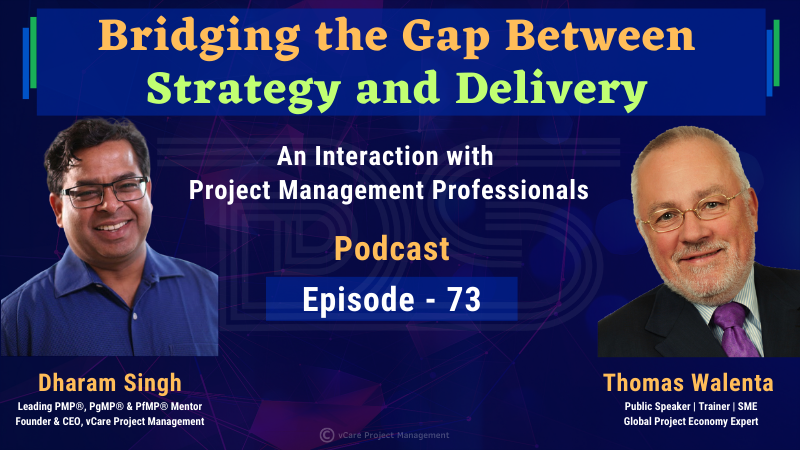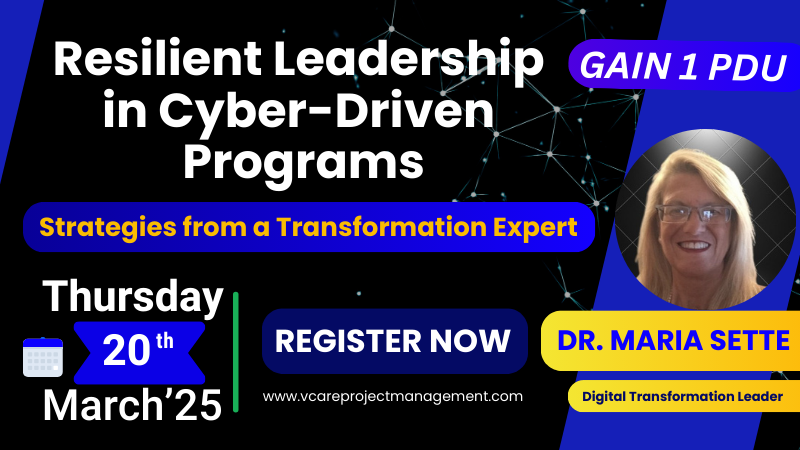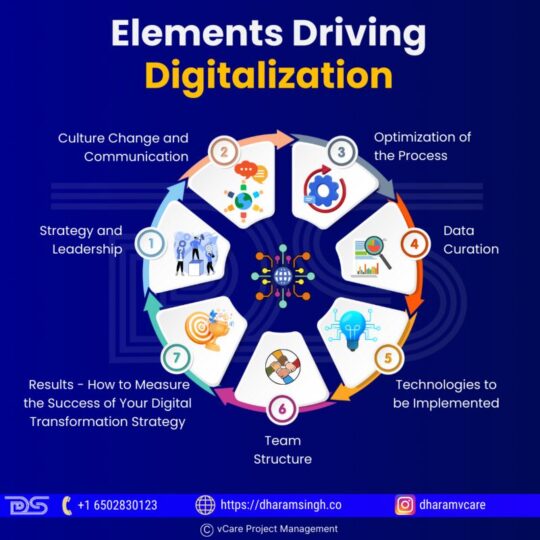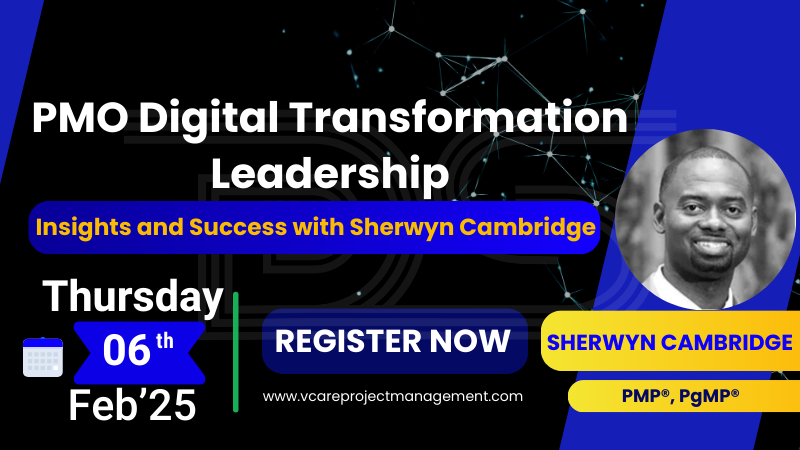
by DharamCW | Mar 15, 2025 | Podcast, Project-Program-Portfolio Management Knowledge
Bridging the Gap Between Strategy and Delivery | Thomas Walenta | Dharam | Episode 73
🎥 Watch now: https://youtu.be/ttQuV57dL4c
📝 Discussion Topics:
– Bridging the Gap Between Strategy and Delivery
– What are the most common challenges in aligning strategy with execution, and how can organizations overcome them?
– Discuss the importance of visionary leadership in strategy execution and how leaders can effectively communicate and unite their teams around strategic goals?
– How will emerging technologies such as AI and blockchain impact strategy execution in the next five years? Can you provide specific examples of these technologies in action?
– What is your strategy to utilize these new technologies in your business to create more value for your customers?
– How important is organizational culture in determining the success of strategy execution, and what steps can leaders take to foster a culture that supports strategic goals?
– Share a strategic initiative from your past that didn’t go as planned and the lessons learned from that experience.
– What are the key skills and competencies must tomorrow’s leaders develop to excel in strategy execution, considering the fast-paced changes in global markets and technologies?
– How can organizations use advanced analytics and data insights to improve their strategic execution? Are there specific sectors or projects where this is particularly critical?
🚀 Looking to deepen your knowledge? Check out my upcoming webinars featuring global experts,
1. Resilient Leadership in Cyber-Driven Programs: Strategies from a Transformation Expert featuring Dr. Maria Sette – https://bit.ly/4j9fmPA
2. Strategic Leadership & Operational Excellence featuring Jay Brough – https://bit.ly/41sSraX
– Book an obligation-free consultation session on Project management Career, training, and certifications: http://talktodharam.com
– Discover training offers and certification discounts: https://bit.ly/3jWVepD
– Stay updated with our Q&A series and certification success stories by subscribing to the vCare Project Management YouTube channel at https://bit.ly/2YF0wJl
– Follow my podcasts and interviews with Project Management Experts on YouTube at https://bit.ly/2NDY8wd
#StrategyExecution #Leadership #VisionaryLeadership #StrategyAndExecution #EmergingTechnologies #AIinBusiness #BlockchainStrategy #DigitalTransformation #TechInBusiness #OrganizationalCulture #AdvancedAnalytics #BusinessStrategy #FutureOfWork #PgMP #PfMP #PMP #AskDharam #DharamSingh #vCareProjectManagement

by DharamCW | Mar 10, 2025 | Professional Development Webinars, Uncategorized

by DharamCW | Mar 7, 2025 | Project-Program-Portfolio Management Knowledge
Bridging the Gap Between Strategy and Delivery | Thomas Walenta | Dharam | Episode 73
📝 Discussion Topics:
– Bridging the Gap Between Strategy and Delivery
– What are the most common challenges in aligning strategy with execution, and how can organizations overcome them?
– Discuss the importance of visionary leadership in strategy execution and how leaders can effectively communicate and unite their teams around strategic goals?
– How will emerging technologies such as AI and blockchain impact strategy execution in the next five years? Can you provide specific examples of these technologies in action?
– What is your strategy to utilize these new technologies in your business to create more value for your customers?
– How important is organizational culture in determining the success of strategy execution, and what steps can leaders take to foster a culture that supports strategic goals?
– Share a strategic initiative from your past that didn’t go as planned and the lessons learned from that experience.
– What are the key skills and competencies must tomorrow’s leaders develop to excel in strategy execution, considering the fast-paced changes in global markets and technologies?
– How can organizations use advanced analytics and data insights to improve their strategic execution? Are there specific sectors or projects where this is particularly critical?
🎥 Watch now: https://youtu.be/ttQuV57dL4c
🚀 Looking to deepen your knowledge? Check out our upcoming webinars featuring global experts,
1. Turning Business Goals into Reality featuring Marcelo Pessotto – https://bit.ly/4hhH4Yu
2. Resilient Leadership in Cyber-Driven Programs: Strategies from a Transformation Expert featuring Dr. Maria Sette – https://bit.ly/4j9fmPA
– Book an obligation-free consultation session on Project management Career, training, and certifications: http://talktodharam.com
– Discover training offers and certification discounts: https://bit.ly/3jWVepD
– Stay updated with our Q&A series and certification success stories by subscribing to the vCare Project Management YouTube channel at https://bit.ly/2YF0wJl
– Follow my podcasts and interviews with Project Management Experts on YouTube at https://bit.ly/2NDY8wd
#StrategyExecution #Leadership #VisionaryLeadership #StrategyAndExecution #EmergingTechnologies #AIinBusiness #BlockchainStrategy #DigitalTransformation #TechInBusiness #OrganizationalCulture #CultureInBusiness #DataDrivenDecisions #AdvancedAnalytics #InnovationLeadership #StrategicGoals #BusinessStrategy #FutureOfWork #GlobalMarkets #PgMP #PfMP #PMP #askdharam #dharamsingh #dharamsinghpgmp #dharamsinghpfmp #dharamsinghpmp #vcareprojectmanagement

by DharamCW | Jan 28, 2025 | General, Project Management
Traditional businesses worldwide have long recognized that digital transformation is the key to thriving in a fast-paced world. Digital transformation involves integrating digital technology into all aspects of a business. It fundamentally alters how businesses operate and provide value to customers. It increases efficiency, transparency, customer experience, employee engagement, and culture and saves time and money. Modern digital tools have elevated the project management process to new heights.
The following are the seven critical elements of a successful strategic digital transformation framework:
1. Strategy and Leadership
2. Culture Change and Communication
3. Optimization of the Process
4. Data Curation
5. Technologies to be Implemented
6. Team Structure
7. Results – How to Measure the Success of Your Digital Transformation Strategy

Elevate your business with a strong digital transformation strategy! Learn the 7 critical success factors.
🚀 Looking to deepen your knowledge? Check out our upcoming webinars featuring global experts,
1. PMO Digital Transformation Leadership: Insights and Success featuring Sherwyn Cambridge – https://bit.ly/4iMvyWE
2. Culture, People, Programs, Risks: Leadership Redefined featuring Lucie Ellis – https://bit.ly/3VXv4mW
3. Turning Business Goals into Reality featuring Marcelo Pessotto – https://bit.ly/4hhH4Yu
4. Resilient Leadership in Cyber-Driven Programs: Strategies from a Transformation Expert featuring Dr. Maria Sette – https://bit.ly/4j9fmPA
– Book an obligation-free consultation session on Project management Career, training, and certifications: http://talktodharam.com
– Discover training offers and certification discounts: https://bit.ly/3jWVepD
– Stay updated with our Q&A series and certification success stories by subscribing to the vCare Project Management YouTube channel at https://bit.ly/2YF0wJl
– Follow my podcasts and interviews with Project Management Experts on YouTube at https://bit.ly/2NDY8wd
#DigitalTransformation #BusinessStrategy #TechInnovation #CultureChange #ProcessOptimization #DataDriven #DigitalStrategy #TechLeadership #AskDharam #DharamSingh

by DharamCW | Jan 24, 2025 | Professional Development Webinars
PMO Digital Transformation Leadership: Insights and Success with Sherwyn Cambridge PgMP®, PMP®, MBA® | vCare PgMP Success Story
I am excited to host an exclusive webinar featuring Sherwyn Cambridge, a distinguished Digital Transformation Leader and the current Delivery Head at iGovTT in Port of Spain, Republic of Trinidad and Tobago. With over a decade of experience in ICT programs and project management, Sherwyn has led transformative initiatives that have enhanced public sector operations, increased efficiency and delivered impactful, citizen-centered solutions.
Key topics include:
• Enabling Digital Transformation through PMO Leadership
• The Impact of PgMP Certification on Multi-Stakeholder Projects
• Mitigating Digital Transformation Failures through PMO Governance
• Leveraging AI-Driven Tools for Decision-Making
• Strategies for Overcoming Public-Sector Transformation Challenges
• Adaptive Leadership in Complex Digital Transformation Programs
🔗 Reserve your spot now: https://bit.ly/4iMvyWE
Session Date: Thursday, 6th February 2025
Session Time: 10:30 AM – 11:30 AM (PST) / 11:30 AM – 12:30 PM (MST) / 12:30 PM – 01:30 PM (CST) / 01:30 PM – 02:30 PM (EST) / 02:30 PM – 03:30 PM (AST) / 03:30 PM – 04:30 PM (BRT) / 06:30 PM – 07:30 PM (GMT) / 07:30 PM – 08:30 PM (CET) / 09:30 PM – 10:30 PM (AST) / 10:30 PM – 11:30 PM (GST)
🚀 Elevate Your Project Management Career:
– Book an obligation-free consultation session on Project management Career, training, and certifications: http://talktodharam.com
– Discover training offers and certification discounts: https://bit.ly/3jWVepD
– Stay updated with our Q&A series and certification success stories by subscribing to the vCare Project Management YouTube channel at https://bit.ly/2YF0wJl
– Follow my podcasts and interviews with Project Management Experts on YouTube at https://bit.ly/2NDY8wd
#DigitalTransformation #PMOLeadership #ProjectManagement #PgMP #AIinPM #PMO #TrinidadAndTobago #LeadershipInTech #GovTech #PublicSectorTransformation #DigitalLeadership #AIforPM #TransformationLeadership #MultiStakeholderProjects #DigitalGovernance #PMOSuccess #AdaptiveLeadership #VcareProjectManagement #PfMP #PMP #AskDharam #DharamSingh #DharamSinghPgMP #DharamSinghPfMP #DharamSinghPMP










🚀 Mastering Resilient Leadership in Cyber-Driven Programs! 🚀
Join me for an exclusive LIVE webinar with Dr. Maria Sette, PgMP®, PMP®, PMOCP®, a renowned Digital Transformation Leader in Cybersecurity and IT Consulting. 🌍
Date: Thursday, 20th March 2025
Time: 10:30 AM – 11:30 AM (PDT) / 11:30 AM – 12:30 PM (MDT) / 12:30 PM – 01:30 PM (CDT) / 01:30 PM – 02:30 PM (EDT) / 02:30 PM – 03:30 PM (BRT) / 05:30 PM – 06:30 PM (GMT) / 06:30 PM – 07:30 PM (CET) / 08:30 PM – 09:30 PM (AST) / 09:30 PM – 10:30 PM (GST)
🔗 Reserve Your Spot Now: https://bit.ly/4j9fmPA
🔥 What’s in it for YOU? 🔥
✅ Leadership in Real-World Cybersecurity Challenges: Lessons and Case Studies
✅ Balancing Innovation and Compliance in Regulated Environments
✅ Fostering Collaboration Between Technical and Non-Technical Teams for Program Resilience
✅ Building Stakeholder Trust Amid Evolving Cybersecurity Threats
✅ Striking the Balance: Security Measures vs. Agility in Cyber-Driven Programs
✅ Leveraging AI-Powered Tools for Proactive Threat Management and Scalability